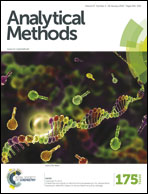Metabolic profiles of 11,13α-dihydroixerin Z in rats using high performance liquid chromatography-LTQ-Orbitrap mass spectrometry
Abstract
A highly sensitive and specific HPLC-ESI-LTQ-Orbitrap combined with a multiple mass defect filter (MMDF) method was used to profile and identify the metabolites of 11,13α-dihydroixerin Z (DIZ) in rats. Plasma was collected after intravenous administration of DIZ to the rats (50 mg kg−1). Based on the accurate mass measurements, the retention time and mass fragmentation patterns, in total, 40 metabolites were tentatively identified and characterized. The distribution of the metabolites in rats was reported for the first time. Hydroxylation, hydrolysis, methylation, cysteine conjugation, glutathione (GSH) conjugation, sulfate conjugation, N-acetylcysteine conjugation, and glucuronidation were found to comprise the major metabolic reactions of DIZ in rats. These results are very helpful for the better comprehension of the metabolism and can also give strong indications about the effective forms of DIZ in vivo.


 Please wait while we load your content...
Please wait while we load your content...